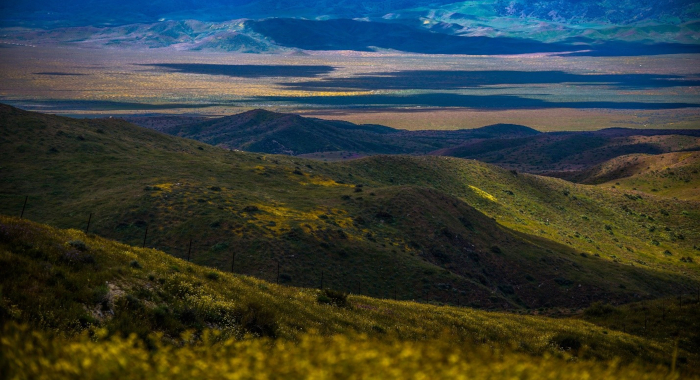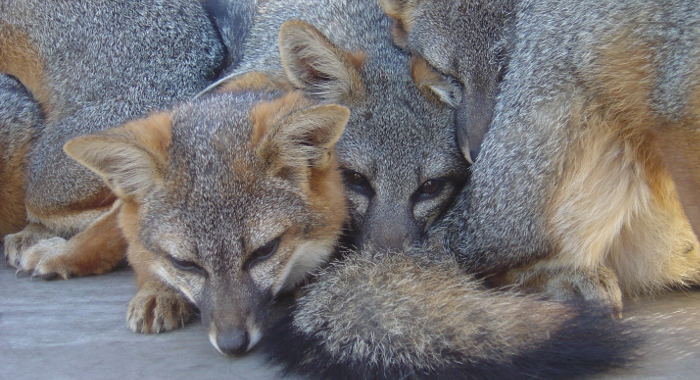Nearly half of California is protected in some land status that prevents most kinds of intensive human land uses. These lands support extensive natural habitats, and for many species, are a critical stronghold in an increasingly human-dominated world.
Yet, changes in the landscape in and near these places have left many in a degraded and precarious condition. Catastrophic wildfire, invasive species, and climate change threaten vast swathes of the state. Protected lands are becoming increasingly isolated by urban and agricultural development, roads, and other infrastructure. Such obstacles can limit a species’ ability to move to across the landscape and adapt to climate change.
Conservancy scientists are working to enhance the resiliency of protected lands in the face of rapid change, and to maintain the landscape connections necessary for plants and animals to adapt over time.


John C. Stella, Li Kui, Gregory H. Golet, Frank Poulsen
Streamside forests are incredibly important for fish, birds and other wildlife. They are also valuable for storing carbon which is needed to combat climate change. This is especially the case in…Case study by: K.D. Holl, G.H. Golet
Advancing conservation requires understanding the constraints imposed on natural systems by human societies. This understanding typically comes from engagement with local stakeholders, as opposed…O.J. Robinson, V. Ruiz-Gutierrez, M.D. Reynolds, G.H. Golet, M. Strimas-Mackey and D. Fink
Information on species’ habitat associations and distributions, across wide spatial and temporal scales, is fundamental for guiding conservation. Yet these data are often in short supply. In…Moses Katkowski, H. Scott Butterfield, John Knapp, Kelly Easterday, Laura Riege, Mark Reynolds
This 5-year action plan describes the vision for invasive plant species mapping, monitoring and treatment at the Jack and Laura Dangermond Preserve in Sourthern California. The plan is adaptive and…Maria C Viteri, Mary Allison Stegner, Elizabeth A. Hadly
Biodiversity monitoring is a core part of conservation practice, however all sampling methods include biases. In particular, small mammal live-trapping, the field standard, produces highly skewed…Elizabeth S. Forbes, Peter S. Alagona, Andrea J. Adams, Sarah E. Anderson, Kevin C.Brown, Jolie Colby, Scott D. Cooper, Sean M. Denny, Elizabeth H.T. Hiroyasu, Robert Heilmayr, Bruce E. Kendall, Jennifer A. Martin, Molly Hardesty-Moore, Alexis M. Mychajliw, Brian P. Tyrrell, Zoë S.Welch
Species reintroductions in a changing world are difficult and highly uncertain. This paper introduces a framework to assess habitat suitability using historic, geographic, and taxonomic analogies to…Alyssa E. Semerdjian, H. Scott Butterfield, Robert Stafford, Michael F. Westphal, William T. Bean
This paper in the Journal of Wildlife Management combines nearly 20 years of remote sensing, field/trapping, and modeling data to develop a new approach to the identification and prioritization of…Christopher J. Lortie, Alessandro Filazzola, Charlotte Brown, Jacob Lucero, Mario Zuliani, Nargol Ghazian, Stephanie Haas, Malory Owen, H. Scott Butterfield, Emmeleia Nix, Michael Westphal
There are many pressures that influence the ecological capacity and health of drylands around the world. Shrubs are often a critical component of these systems and can function positively as…H. Scott Butterfield, T. Rodd Kelsey, and Abigail K. Hart, Editors
As the world population grows, so does the demand for food, putting unprecedented pressure on agricultural lands. At the same time, climate change, soil degradation, and water scarcity mean that…Tom Baribault, Daniel Porter, Jessica Burton Desrocher, Douglas Larmour, Mark Rasmussen, Roy Anderson
The Tahoe-Central Sierra Initiative (TCSI) area has seen recent megafires and is highly developed, making the risk new of human-caused wildfire ignitions high. In this report, experts from Mason Bruce…Daniel Porter, Robert Longcor
Forests of the Sierra Nevada and across the western U.S. are under unprecedented threat from catastrophic wildfire, insect outbreaks, and drought. In this briefing paper, which was developed as a…Sophie S. Parker, Andy Zdon, William T. Christian, Brian S. Cohen, Maura Palacios Mejia, Naomi S. Fraga, Emily E. Curd, Kiumars Edalati, Mark A. Renshaw
This paper presents results from the Mojave Desert Springs research project, and discusses why the conservation of these groundwater-dependent ecosystems is so critical to biodiversity. The authors…M. Florencia Miguel, H. Scott Butterfield, Christopher J. Lortie
This meta-analysis provides a global synthesis of the which restoration practices – active vs. passive – are most successful at restoring plants, animals, and other ecosystem functions to…Maura Palacios Mejia, Emily Curd, Kiumars Edalati, Mark A. Renshaw, Roy Dunn, Daniel Potter, Naomi Fraga, Jenna Moore, Justin Saiz, Robert Wayne, Sophie S. Parker
This paper presents results from the Mojave Desert Springs research project. The authors used an environmental DNA (eDNA) technique to assess biodiversity at four naturally occurring springs. They…Ethan Inlander, Katie Andrews, Contributors: Jennifer Chin, Sue Pollock, Mike McFadden, Scott Hardage, Scott Butterfield, Tod Rubin
With this publication, TNC in California marks a major shift in its approach to conservation easement monitoring. At the crossroads of conservation, stewardship and technology lies remote property…Dr. Winston Vickers, Karen C. Drayer, Trish Smith, Brian Cohen
Highways across the greater San Diego region in southern California are major barriers and causes of mortality for mountain lions and are contributing to the species’ genetic restriction and…Rodd Kelsey, Scott Butterfield, Abigail Hart, Ruthie Redmond, Hope Bigda-Peyton
This Policy Brief summarizes the results of a study on the potential for strategic habitat restoration in the San Joaquin Valley of California as an important part of reducing overall water…Butterfield, H.S., M. Katkowski, J. Cota, O. Sage, C. Sage, K. Easterday, D. Zeleke, L. Riege, S. Gennet, K. Lin, B. Leahy, M. Bell, M. Reynolds
Cattle grazing is the dominant land management tool TNC has to manage biodiversity and reduce the threat of catastrophic wildfire at the TNC's Jack and Laura Dangermond Preserve. This…